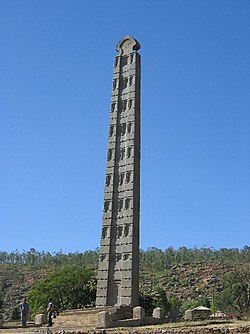Aksum
| Aksum (ኣኽሱም) | |
|---|---|
| City | |

Northern Stelae Park
|
|
| Coordinates: 14°7′15″N 38°43′40″E / 14.12083°N 38.72778°ECoordinates: 14°7′15″N 38°43′40″E / 14.12083°N 38.72778°E | |
| Country |
|
| Region | Tigray |
| Zone | Mehakelegnaw |
| Elevation | 2,131 m (6,991 ft) |
| Aksum | |
|---|---|
| Name as inscribed on the World Heritage List | |
 |
|
| Type | Cultural |
| Criteria | i, iv |
| Reference | 15 |
| UNESCO region | Africa |
| Inscription history | |
| Inscription | 1980 (4th Session) |
Axum or Aksum (Tigrinya: ኣኽሱም? /axsum/, Amharic: አክሱም? /aksum/) is a city in the northern part of Ethiopia. The town has a population of 56,500 residents (2010), and is governed as an urban wäräda.
The original capital of the Kingdom of Aksum, it is one of the oldest continuously inhabited places in Africa. Axum was a naval and trading power that ruled the region from about 400 BCE into the 10th century. In 1980 UNESCO added Aksum's archaeological sites to its list of World Heritage Sites due to their historic value.
Located in the Mehakelegnaw Zone of the Tigray Region near the base of the Adwa mountains, Axum has an elevation of 2,131 metres (6,991 ft). Axum is surrounded by La'ilay Maychew wäräda.
Axum was the center of the marine trading power known as the Aksumite Kingdom, which predated the earliest mentions in Roman era writings. Around 356 CE, its ruler was converted to Christianity by Frumentius. Later, under the reign of Kaleb, Axum was a quasi-ally of Byzantium against the Sasanian Persian Empire which had adopted Zoroastrianism. The historical record is unclear, with ancient church records the primary contemporary sources.
...
Wikipedia

